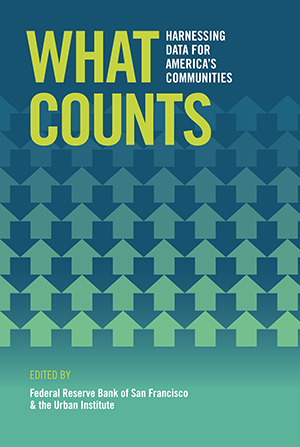By Federal Reserve Bank of San Francisco and the Urban Institute
With 90 percent of the world’s data generated in just the past two years, a new book released today challenges policymakers, funders, and practitioners across sectors to seize this new opportunity to revolutionize our approaches to improve lives in low-income
communities. What Counts: Harnessing Data for America’s Communities from the Federal Reserve Bank of San Francisco and the Urban Institute provides a roadmap for the strategic use of data to
reduce poverty, improve health, expand access to quality education, increase employment, and build stronger and more resilient communities.
The book—a series of essays from some of the nation’s most innovative social entrepreneurs and data experts—is a resource for those working in community development, finance, government, philanthropy, health and other sectors. Funding for this project
was provided to the Urban Institute by the Robert Wood Johnson Foundation. The essays address all aspects of this new data-driven approach, from high-level systems change to practical “how-to” guides and online tools for communities.
“Not long ago, we had a problem of insufficient data. Today, we have more data than ever before, but we still need to build capacity to use it in meaningful ways,” said Kathryn Pettit, a senior research associate at the Urban Institute and one of the book’s senior editors. “Better and more efficient use of data can help leaders understand what is working and for whom and develop smarter and more coordinated efforts.”
The book addresses such questions as:
- What are the opportunities to use data from a variety of sources across multiple measures, including poverty rates, employment rates, graduation rates, and health status?
- How can increased access to mortgage data improve assessment of market trends and provide early warnings of trouble?
- How can increased access to data on how hospitals allocate “community benefit” resources promote more coordinated action among those tackling the upstream determinants of health?
- What’s important to consider when deciding which data to collect and analyze?
- How can data be used to determine resource gaps, service redundancies, or opportunities for cost savings?
- Why are standard metrics and data important, particularly for Community Development Financial Institutions and the health sector?
- How can practitioners transform data into actionable information and compelling stories and get key messages into the hands of decision-makers?
- How does an organization’s culture and leadership advance or limit efforts to use data more strategically? Why does establishing a different approach to using data require more than just better information?
“Meaningful social change requires complex interactions among people, institutions, and policies. Data can serve as a common language to help align community strategies,” said Naomi Cytron,
senior research associate at the Federal Reserve Bank of San Francisco and senior book editor. “We published this book to spur collaboration on building better data infrastructure and practices that can ultimately improve neighborhoods and lives.”
The book is organized into broad themes:
- Transforming Data into Policy-Relevant Information offers a glimpse into the array of data tools and approaches that advocates, planners, investors, developers and others are currently using to inform and shape local and regional processes.
- Enhancing Data Access and Transparency focuses on expanding the range of data that is commonly within reach and finding ways to link data across multiple policy and program domains, while ensuring that privacy and security are respected.
- Strengthening the Validity and Use of Data focuses on the capacity of practitioners and policymakers to use data for understanding and shaping community change.
- Adopting More Strategic Practices examines the roles that practitioners, funders, and policymakers have in improving the ways we capture the multi-faceted nature of community change, communicate about the outcomes and value of our work,
and influence policy at the national level.
What Counts: Harnessing Data for America’s Communities builds on key themes of a 2012 book—Investing in What Works for America’s Communities—that was published by the Federal Reserve Bank of San Francisco and the Low Income Investment Fund. A key focus of that book was the importance of collaboration across sectors and institutions—for example, establishing strategies to ensure that residents of affordable housing can readily access transportation networks, or that children’s health initiatives take neighborhood safety concerns into account. The Federal Reserve Bank of San Francisco and the Urban Institute partnered to publish What Counts in an effort to show that data is critical for aligning this cross-sector, multi-institution work.
The Federal Reserve System works to support the economic growth objectives of the Federal Reserve Act by promoting community development and fair and equal access to credit. The Urban Institute conducts social and economic policy research, building an
evidence base of what works to support vulnerable communities.
Read the full book at whatcountsforamerica.org
The views expressed here do not necessarily reflect the views of the management of the Federal Reserve Bank of San Francisco or of the Board of Governors of the Federal Reserve System.
